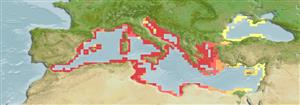Teleostei (teleosts) >
Eupercaria/misc (Various families in series Eupercaria) >
Labridae (Wrasses)
Etymology: Symphodus: Greek, syn, symphysis = grown together + Greek, odous = teeth (Ref. 45335).
More on author: Bloch.
Environment: milieu / climate zone / depth range / distribution range
Ecology
Marine; reef-associated; depth range 1 - 50 m. Subtropical; 47°N - 30°N, 6°W - 36°E
Eastern Atlantic: throughout the Mediterranean and western part of Black Sea.
Size / Weight / Age
Maturity: Lm ? range ? - ? cm
Max length : 17.7 cm TL male/unsexed; (Ref. 122896); max. published weight: 73.88 g (Ref. 122896); max. reported age: 4 years (Ref. 4742)
Adults are found near rocks, mainly in eel-grass beds. Adhesive eggs laid by one or more female in nest of algae built by male (Ref. 4742). Males grow faster than females (Ref. 4742). Oviparous (Ref. 205).
Life cycle and mating behavior
Maturity | Reproduction | Spawning | Eggs | Fecundity | Larvae
Oviparous (Ref. 205). Adhesive eggs are laid by one or several females on a nest of algae built by a male (Ref. 4742).
Quignard, J.-P. and A. Pras, 1986. Labridae. p. 919-942. In P.J.P. Whitehead, M.-L. Bauchot, J.-C. Hureau, J. Nielsen and E. Tortonese (eds.) Fishes of the north-eastern Atlantic and the Mediterranean. UNESCO, Paris. Vol. 2. (Ref. 4742)
IUCN Red List Status (Ref. 130435)
Threat to humans
Harmless
Human uses
Aquarium: commercial
More information
ReferencesAquacultureAquaculture profileStrainsGeneticsElectrophoresesHeritabilityDiseasesProcessingNutrientsMass conversion
Tools
Special reports
Download XML
Internet sources
Estimates based on models
Preferred temperature (Ref.
123201): 16.2 - 21.3, mean 18.9 °C (based on 124 cells).
Phylogenetic diversity index (Ref.
82804): PD
50 = 0.5005 [Uniqueness, from 0.5 = low to 2.0 = high].
Bayesian length-weight: a=0.00589 (0.00425 - 0.00815), b=3.17 (3.08 - 3.26), in cm total length, based on LWR estimates for this species (Ref.
93245).
Trophic level (Ref.
69278): 3.5 ±0.0 se; based on diet studies.
Resilience (Ref.
120179): Medium, minimum population doubling time 1.4 - 4.4 years (K=0.36-0.90; tmax=4).
Fishing Vulnerability (Ref.
59153): Low vulnerability (20 of 100).
Nutrients (Ref.
124155): Calcium = 63.1 [30.6, 139.1] mg/100g; Iron = 0.836 [0.443, 1.681] mg/100g; Protein = 19.2 [16.4, 21.5] %; Omega3 = 0.257 [0.141, 0.475] g/100g; Selenium = 13.7 [6.2, 28.4] μg/100g; VitaminA = 67.1 [19.0, 311.4] μg/100g; Zinc = 1.17 [0.71, 1.99] mg/100g (wet weight);
